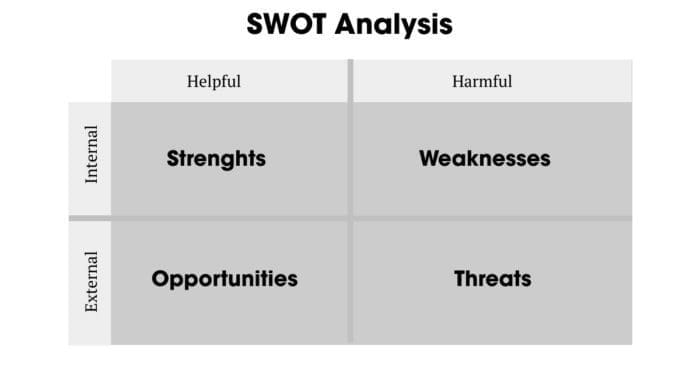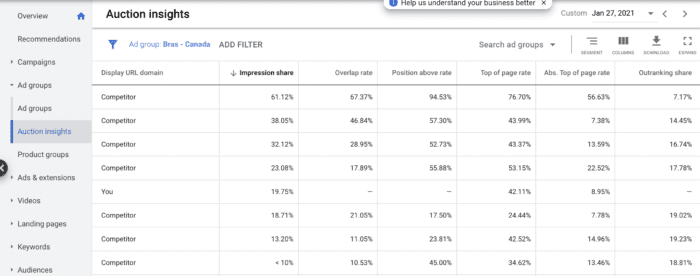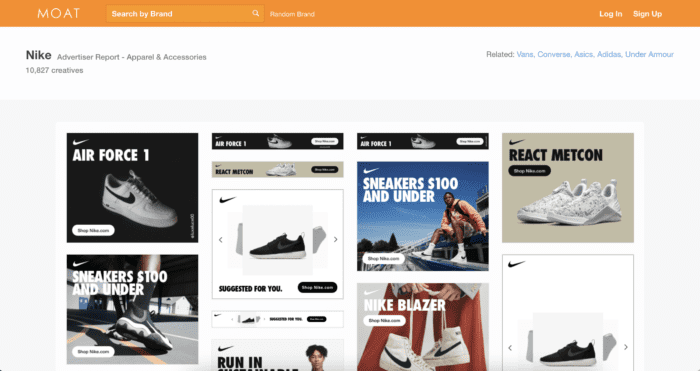Whether you like it or not, your competitors influence many aspects of your business. Your competitors dictate what dangers exist for your business, but also what gaps are available for you to take advantage of.
This is why you need a competitor analysis for your digital marketing strategy.
In short, a competitor analysis allows you to assess the strengths and weaknesses of businesses that share the same target market as you.
This type of analysis gives you a strategy to gather information about your competitors, but also how to use it to develop a defensive and offensive strategy. Once your competitive analysis is complete, you should be able to develop your own SWOT analysis which regroups your Strengths, Weaknesses, Opportunities and Threats.

Why Is A Competitor Analysis Important?
First off, a competitor analysis is the only way to know how your business stands in the market compared to other businesses like yours.
It allows you to discover two important things:
- The opportunities or gaps that exist in the market right now
- The dangers you need to be aware of
Without a competitor analysis, your digital marketing strategy won’t be as effective, since you won’t have the insight about your competitors to know what holes you can fill in the market – as well as what weaknesses you need to fix in your own business in order to stand out.
For example, you can use the data you uncover in your analysis to:
- Outrank competitors for specific keywords in Google
- Get more customers by offering a unique value proposition your competitors are missing
- Establish a pricing strategy that makes sense for your market
- Get inspiration for how to show up on social media
- And so much more!
By analyzing your competitors, you’ll also know who to watch on a regular basis to ensure you’re not falling behind. This is a proactive way to stay on top of your market and understand the competitive landscape.
The intelligence you gain from an effective competitor analysis will allow you to make strategic decisions instead of going with your gut or guessing what to do next.
How To Find Who Your Actual Online Competitors Are
Before you can complete a competitor analysis, you need to know which businesses to look into.
If you’re trying to beat the wrong competitors, your digital marketing strategy won’t be as effective, since the wrong competitors don’t have the same target audience as you.
Start by listing who you think your competitors are from previous experience.
With this starting point out of the way, pinpoint your most valuable keywords and figure out which businesses are currently ranking for them.
You can use SEMrush, Moz, Ahrefs, or any other SEO tool to research these keywords effectively.
Once you have this data, you’ll be able to either confirm your assumptions about your competitors or add new ones to your list.
If you don’t have an SEO tool, you can also perform a local or generic Google search to see who shows up organically – and to check who is paying for these keywords to show up at the top of the first page.
Gather As Much Information As You Can About Your Competition
Now that you’ve verified who your competitors are, you can figure out their strengths and weaknesses by performing in-depth research and analysis. Here’s a step-by-step process of how to do a competitor analysis so you don’t miss anything!
“Spy” On Your Competitors Online
Do you know what ad platforms your competitors are using?
You can use Chrome extensions, such as Wappalyzer or Ghostery, to analyze any web page to see what trackers they are using.
These trackers will give you insight into what ad platforms they use to advertise.
For instance, if you spot an active LinkedIn Insight Tag, there’s a good chance they’re running LinkedIn Ads. You can also use these tools to spot other tools like HotJar or Mailchimp.
1. Assess Their Social Media Presence
Verify what social media platforms your competitors are using (Tiktok, Facebook, Instagram, Pinterest, LinkedIn, Snapchat, Youtube) to analyze their organic posts.
For instance, what type of content do they share, and how often? Which posts are getting the most comments?
But you should also check paid ads for social media.
You can always verify whether or not competitors are running ads on almost any platform by searching each platform’s ad library:
- Facebook Ad Library for Facebook
- Check the ‘Posts’ tab and click on ‘Ads’ when visiting a business page on Linkedin
- Take a look at their Pinterest Borads
When you spot an ad, note what format your competitors are using. Are they using images, videos, or carousels? Is their copy long-form or short-form? What type of promotions are they running?
2. Analyze Their Search Engine Visibility
Next, you need to check how your competitors show up on search engines.
2.1 Organic
Organic SEO visibility breaks down into three main pillars:
- Content
- Authority
- Technical
Searching manually on Google will allow you to analyze the content aspect of your competitors’ visibility. However, you’ll need a specialized SEO tool, such as SEMrush, to dig into the other two.
For example, how much traffic are they actually driving to their site? What is the exhaustive list of keywords they’re ranking for?
You’ll also want to uncover which domains link back to their site, what are their most popular blog posts, articles, or web pages, and get some insight into technical metrics, such as:
- Site speed
- Broken links
- Descriptions and titles that aren’t well optimized for SEO
By acquiring all this intelligence, you’ll identify patterns throughout your competitors’ SEO strategies, but you’ll also gain insight into what leads to strong search performance in your market.
Additionally, you will get inspiration for what you can write about next, or which domains you should go after for backlinks!
2.2 Paid Search
Instead of manually checking all paid search platforms, you can use SEMrush to make a marketing analysis of paid advertising strategies.
You can find out what type of ad copy your competitors and industry leaders are using, but also which keywords and search terms they’re bidding on and how much they’re spending.
However, if you’re currently advertising on Google and Bing, Google Ads Auction Insights and Bing auction insights will give you highly valuable insights for your competitor research.

3. Display Advertising
Finally, you should look into the display advertising strategies of your competitors.
The first way to do this is to use Moat.com, which shares recent Google Display Ads for thousands of companies.

However, you can also visit your competitors’ websites and verify if remarketing ads show up while you’re browsing afterward.
Start Your Competitive Analysis Right Away
Competitor analyses are vital to helping you grow your business – but they require a ton of resources to get done effectively. Get in touch with the Bloom team today to get a complete competitive analysis!
Subscribe to The Shift Factor
Our newsletter keeps you in the know on marketing’s biggest shifts and real examples of brands adapting.




Share this: